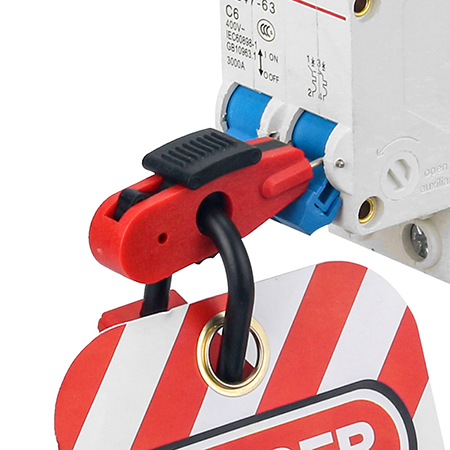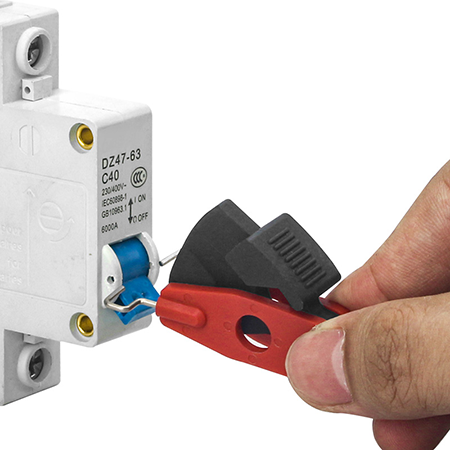Electrical Lockouts, also known as Electrical Equipment Lockouts, are important safety tools used in workplaces to protect people from electrical dangers. These devices are designed to stop electrical equipment from being turned on by accident when someone is working on it or fixing it. They work by physically blocking switches or power sources, making sure the equipment stays off until it's safe to use again. Electrical Lockouts come in different forms, like special locks, tags, or devices that fit over switches. They are used on things like circuit breakers, power switches, and other parts of electrical systems. The main goal of using these lockouts is to prevent serious accidents like electric shocks or fires that can happen if equipment is turned on unexpectedly. Many workplaces are required by law to use these safety devices, and they are a key part of keeping workers safe around electrical equipment. By using Electrical Lockouts, companies can make their workplaces much safer, reduce the chance of accidents, and help workers feel more secure when dealing with electrical systems. This simple but effective safety measure is crucial in many industries to protect lives and prevent injuries.

Benefits of using Electrical Lockouts
Prevents Accidental Energization
Electrical Lockouts stop equipment from being turned on by mistake. This is their most important job. When someone is working on electrical equipment, there's always a chance that another person might not know and try to turn the power back on. This could cause a very serious accident. The lockout device acts like a physical barrier, blocking the switches or power sources. Even if someone tries to turn the equipment on, they can't. This simple but powerful method greatly lowers the risk of electric shocks, burns, or other injuries that could happen if equipment suddenly got power while someone was working on it. For example, if a maintenance worker is fixing a big machine and has turned off the power, a lockout would stop anyone else from turning it back on by accident. This keeps the worker safe and prevents dangerous surprises.
Enhances Workplace Safety
Using Electrical Lockouts makes the whole workplace safer. It's not just good for the people working directly with electrical equipment - it helps everyone. When lockouts are used all the time, it creates a culture of safety. Workers become more aware of possible dangers and are more likely to follow other safety rules too. This can lead to fewer accidents of all kinds, not just electrical ones. Also, a safer workplace means less stress for workers. They can focus on their jobs without worrying about unexpected dangers. This can make them happier at work and more productive. For instance, in a factory, knowing that all machines being repaired are properly locked out can make all workers feel safer. They can concentrate on their own tasks without being afraid of accidents. This improved safety feeling can spread to other areas of work, making the whole workplace safer and more comfortable for everyone.
Complies with Safety Regulations
Many countries have strict rules about workplace safety, especially for electrical work. Using Electrical Lockouts is often required by law. By using a proper lockout system, companies make sure they're following these laws. This helps them avoid fines or other punishments that could come from not meeting safety standards. It also shows that the company takes worker safety seriously, which can be important for its reputation. Following safety rules can also help if there's ever an accident investigation. If a company can show they were using the right lockout procedures, it can protect them from legal problems. This benefit goes beyond just avoiding trouble - it shows that the company values its workers' lives and well-being. It can make workers feel more valued and protected, which can lead to better job satisfaction and loyalty. In the long run, following these regulations can save the company money by avoiding costly accidents and legal issues.
Saves Lives and Prevents Injuries
This benefit is extremely important. Electrical accidents can be very serious, often causing severe injuries or even death. By preventing these accidents, Electrical Lockouts literally save lives. Even less severe electrical accidents can cause painful injuries and long-term health problems. Burns, nerve damage, and heart problems can all happen from electric shocks. By using lockouts, these injuries are prevented, keeping workers healthy and able to keep working. For example, without a proper lockout, a worker might get a bad shock while fixing a circuit, which could send them to the hospital or worse. With a lockout in place, this dangerous situation is completely avoided. This not only protects the workers but also saves the company from the emotional and financial costs of workplace accidents. It helps maintain a positive work environment where employees feel valued and protected, which can lead to better morale and productivity overall.
Provides Clear Communication
Electrical Lockouts are a clear, visual sign that equipment should not be used. This is very important in busy work areas where it might be hard to hear or remember verbal warnings. Many lockout devices come with tags that can be filled out with important information. This might include who put the lockout on, why it's there, and when it will be taken off. This clear communication helps stop misunderstandings that could lead to dangerous situations. For instance, if a machine is locked out for maintenance, the tag could explain exactly what work is being done and when it should be finished. This keeps everyone informed and prevents confusion. It's like a universal language in the workplace - even if workers speak different languages, they can all understand what a lockout means. This clear communication can be especially helpful during shift changes or when different teams are working in the same area, ensuring that important safety information is passed on effectively.
Allows for Multiple User Safety
Many Electrical Lockout devices are made to hold multiple locks. This is very important for situations where several people might be working on the same equipment at different times or in different areas. Each worker can put their own personal lock on the lockout device. This makes sure that the equipment can't be turned back on until every single worker has finished their job and taken off their lock. It gives each individual worker control over their own safety. For example, if an electrical system in a big building is being worked on by both electricians and plumbers, each worker can attach their own lock. The system can't be turned back on until every lock is removed, making sure no one is put in danger. This feature is particularly useful in complex industrial settings or large construction projects where many different specialists might need to work on the same systems. It promotes a sense of personal responsibility for safety and ensures that no one can accidentally endanger a colleague by removing a lockout prematurely.

Conclusion
Electrical Lockouts provide numerous benefits that go beyond just preventing accidents. They create a safer, more productive work environment, ensure legal compliance, save lives, improve communication, and give workers control over their own safety. While they might seem like simple devices, their impact on workplace safety and efficiency is significant.


 2
2





